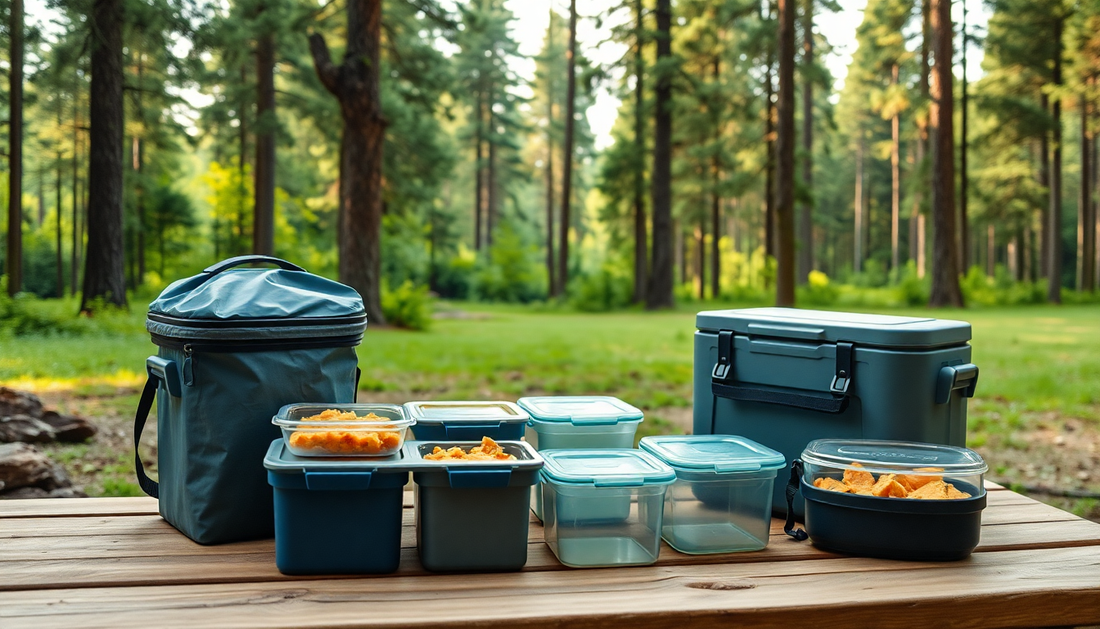
Essential Camping Food Storage Solutions: Keep Your Meals Fresh and Safe Outdoors
Share
Embarking on a camping adventure is an exhilarating experience, but it also comes with the challenge of keeping your food fresh and safe. Whether you're planning a weekend getaway or a week-long expedition, proper food storage is crucial to ensuring your meals are delicious and your campsite remains free of unwanted visitors. In this blog post, we'll explore the essential camping food storage solutions to help you make the most of your outdoor experience.
Understanding the Importance of Proper Food Storage
When you're surrounded by the great outdoors, the elements can pose a significant threat to the longevity and safety of your food. Fluctuating temperatures, moisture, and the presence of wildlife can all contribute to the rapid spoilage of your provisions. Failing to address these concerns can lead to food-borne illnesses, wasted resources, and a less enjoyable camping trip overall.

Types of Camping Food Storage Containers
To combat these challenges, campers have a variety of food storage options at their disposal. Let's take a closer look at the most popular choices:
Hard-Sided Coolers
Sturdy and reliable, hard-sided coolers are a classic choice for camping food storage. These insulated containers are designed to maintain a consistent temperature, keeping your perishables chilled for extended periods. They come in a range of sizes to accommodate your needs, from compact models for solo trips to larger options for group outings.
Soft-Sided Coolers
For a more portable and lightweight option, soft-sided coolers offer a great alternative. These coolers are typically made of durable, insulated fabric and feature convenient carrying handles or straps. While they may not provide the same level of temperature control as their hard-sided counterparts, soft-sided coolers are an excellent choice for day hikes, picnics, or short camping excursions.
Insulated Bags
Insulated bags, often referred to as "lunch boxes," are a versatile option for camping food storage. These compact, lightweight containers are designed to keep your food and beverages at the desired temperature, whether you're packing a quick lunch or storing snacks for the day. Insulated bags are particularly useful for backpacking or minimalist camping trips where space is limited.
Airtight Containers
Airtight food storage containers are essential for protecting your non-perishable items from moisture, pests, and contamination. These containers come in a variety of materials, including plastic, metal, and even silicone, and can be stacked or nested to maximize your packing space.
Key Considerations for Camping Food Storage
When selecting the right food storage solutions for your camping trip, there are several crucial factors to keep in mind:
Temperature Control
Maintaining the proper temperature is crucial for preserving the freshness and safety of your food. Coolers, whether hard-sided or soft-sided, are essential for keeping perishable items like meats, dairy, and fresh produce at a safe temperature.
Moisture Protection
Exposure to moisture can lead to the growth of mold and bacteria, compromising the quality and edibility of your food. Airtight containers and moisture-resistant materials are essential for protecting your provisions from the elements.
Wildlife Prevention
Campsites are often home to a variety of curious wildlife, from bears and raccoons to smaller critters like squirrels and chipmunks. Investing in food storage solutions that are designed to deter these unwanted visitors can help keep your campsite clean and your food secure.
Space Efficiency
When packing for a camping trip, every inch of space counts. Choosing storage containers that are stackable, nested, or designed with a compact footprint can help you maximize your available space and keep your gear organized.
Best Practices for Camping Food Storage
To ensure your camping food stays fresh and safe, follow these best practices:
Packing Techniques
Carefully arrange your food items in your storage containers, placing heavier items on the bottom and lighter items on top. This will help prevent crushing and maintain the integrity of your provisions.
Ice and Cooling Methods
Incorporate ice packs or reusable ice blocks into your coolers to maintain a consistent temperature. Replenish the ice as needed to keep your perishables chilled.
Organization Strategies
Invest in labeled containers or compartmentalized storage solutions to keep your food items separated and easily accessible. This will help you quickly locate what you need and minimize the risk of cross-contamination.
Food Safety Tips
Follow proper food handling and storage guidelines, such as keeping raw meats separate from other items, maintaining a clean preparation area, and discarding any questionable or spoiled food.
Recommended Storage Solutions for Different Camping Scenarios
The ideal camping food storage solution will depend on the duration and nature of your trip. Here are some recommendations for various camping scenarios:
Short Weekend Trips
For short weekend getaways, a compact soft-sided cooler or insulated bag may be sufficient to keep your perishables fresh. Pair it with airtight containers for non-perishable items.
Extended Camping Expeditions
For longer camping trips, a larger hard-sided cooler with ample ice storage capacity is recommended to maintain the temperature of your perishable foods. Supplement with airtight containers for dry goods.
Backpacking and Minimalist Camping
When space is at a premium, opt for lightweight, compact storage solutions like insulated bags and nesting airtight containers. Consider dehydrated or shelf-stable food items to reduce the need for refrigeration.
Family Camping Trips
For family camping trips, a combination of hard-sided and soft-sided coolers, along with a variety of airtight containers, can accommodate the diverse food needs of your group.
Eco-Friendly and Innovative Food Storage Options
As environmental consciousness continues to grow, the camping industry has responded with a range of eco-friendly and innovative food storage solutions. Look for options made from sustainable materials, such as bamboo or recycled plastics, or invest in reusable containers that can be used for multiple trips.

Conclusion
Proper food storage is a crucial aspect of any successful camping adventure. By understanding the different types of storage containers, considering key factors, and implementing best practices, you can ensure your meals stay fresh, safe, and accessible throughout your outdoor excursions. Embrace the essential camping food storage solutions and unlock a world of delicious, worry-free dining under the stars.
